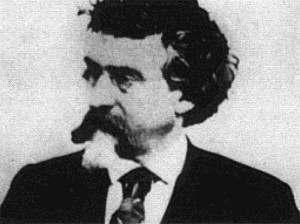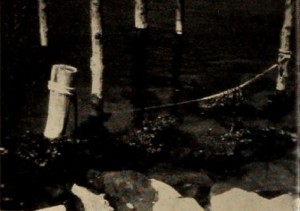
"Charles O. Barr, jr., in Long Remember, has done an extremely difficult thing admirably. This is a Kodachrome record of the recent last meeting of Union and Confederate veterans of the American Civil War on the battlefield of Gettysburg, in Pennsylvania. Because the persons of chief interest, the veterans themselves, were unable to contribute motion to any real extent, Mr. Barr's problem was to avoid using movie footage for still photographs, and yet not to offer an incomplete record of the interesting and historically important gathering. Aided by title wordings that were both dignified and exciting, the maker of this film managed to give to it a sweep of action that, without them, would have bogged down badly. There was motion, of course, in the parades, but these, of themselves, would have been trite fare, had they not been related to the battlefield by shots of watching veterans and by a whole series of admirable angled shots of the statues and markers on Gettysburg field. It is noteworthy that what might have been the dull portions of the record — the construction, housing and victualing arrangements — were given very intelligent, brief handling." Movie Makers, Dec. 1938, 619-620.
"Edited film used by an amateur travel-lecturer documents travel in western and southwestern United States beginning at a rodeo in Phillipsburg, Kansas (trick riding, lassoing jack rabbits, roping calfs, wrestling steers, horse races, bucking broncos and bucking steers as well as scenes of an airplane flyover and of an airplane crashing which possibly was a stunt) and continuing to Black Hills, South Dakota (forest scenery and ca. 1927 construction of Mount Rushmore--blasting off cliff face, scaffolding, men working and completed monument). Shown are roadside scenery, railroad tracks, men cleaning railroad tracks with hose and tank on small train car on the way to an unidentified mountain fishing camp possibly in Colorado (canoeing, fishing in stream, and a smokehouse) and a mountain farm where colts are branded. Cog railway is taken up to Pike's Peak. Travels continue to to the Southwest (unidentified southwestern town possibly Santa Fe with adobe buildings and men and children in Mexican dress singing and playing guitar, American Indian dance performance indoors possibly Zuni, parade of American Indians in unidentified city perhaps Gallup and Navajo band. Scenes of the southwest continue with Navajo in Canyon de Chelly (hogans and herding sheep), prehistoric archaeological sites (Mesa Verde, Chaco Canyon another unidentified cliff dwelling possibly Montezuma's castle) and Taos Pueblo. Film records American Indian dances at a gathering of Indian tribes possibly at Gallup, intertribal horse races and women's tug-of-war. Hopi are shown dancing at Hopi. Also shown are Indian women (possibly Apache or Navajo) and children together and children in cradleboard and the Navajo reservation (hogans, women spinning and weaving under a ramada, herds of sheep and goats and "dipping sheep"). Natural wonders of Grand Canyon, Monument Valley and Rainbow Bridge National Monument are featured.Travel continues to Yellowstone National Park, California (scenery, black bears, hot springs and geysers) and onto the California coast possibly Monterey (seals on rocks). Also shown are an unidentified town with oil pumps and derricks and people waterskiing" via the Human Film Studies Archives, Smithsonian Museum.

"In 1921, Sheeler and Strand collaborated to make Manhatta, considered to be the first American avant-garde film. Inspired by Walt Whitman's poem "Mannahatta," which is quoted in one of the intertitles, the film portrays life in New York City in sixty-five nonnarrative shots. The sequences display one epic day in Lower Manhattan, beginning with a ferry approaching the city in early morning and ending with a sunset view from a skyscraper. Shot from extreme camera angles, the film captures the dynamic qualities of the new metropolis" Museum of Modern Art (New York), Department of Film.
"A visit in New York City but mostly in the spirit of its night life although we do see some of its people and sun-bathed architecture, all to the beat and narration of a Decca recording. The source of the picture material appears to be from magazines and other printed picture sources including some live (but static) posing. The use of camera movement and lens zooming conveys a feeling of motion and activity for an enjoyable visit in New York" PSA Journal, Oct. 1962, 35

"Dr. Crane has a humorous approach for a visit to Boston, Lexington, Concord, Bunker Hill, Plymouth Rock, and the Mayflower II. Each sequence is preceded by a title quotation from a famous writer, to wit: "Boston.....the hub of the solar system" by Holmes; "The fate of the nation was riding that night" by Longfellow; and ends with "the unconquerable rectitude" of the Plymouth Maiden and Edward Crane" PSA Journal, Oct. 1961, 48-49.

"Mathew Brady, the historian with a camera, photographed everyone of importance including Andrew Jackson, Henry Clay, Edgar Allen Poe, Abraham Lincoln, and many battle scenes of the Civil War. This motion picture is built entirely of photographs by Brady and his cameraman. Mr. Southard has used the zoom lens and lap dissolves to create a feeling of movement, supported by a good sound track" PSA Journal, Oct. 1961, 49.

"The third in Steiner’s trilogy of abstract films, Mechanical Principles (1930), is fascinating and more striking than Surf and Seaweed. It is composed of close-up shots of mechanical gears of different kinds in motion; rather than an examination of a single machine, it is an examination of the different kinds of motion produced by machines. Mechanical Principles emphasizes the tension in such machinery between the constancy of force and repetition on the one hand and the irregularity of shapes, sizes, and motions on the other, " Tepperman, 203.

"Unity of theme is the striking characteristic of Jose M. Pavon's Menemsha — and its Achilles heel as well. The producer, in a series of beautifully composed scenes that seem to ebb and flow with the surging rhythm of the sea, has extracted the essence of a small fishing town on the coast of Martha's Vineyard. For almost its entire length, the film emphasizes the salt and the sea and the strange, lovely things of the ocean littoral with a feeling that Mr. Pavon accents brilliantly in double exposures of the shimmering sea water sweeping over even the deserted wharves. Unfortunately, Menemsha's unity breaks down a little as Mr. Pavon's camera roams too far afield and brings in elements that suggest fresh water and inland life rather than his original theme. A little cutting would tighten up a film that, technically and artistically, is a delicate and creative delight." Movie Makers, Dec. 1949, 454.

"Ralph O. Lund, whether he knows it or not, has adopted the same narrative technique used earlier in a nature film (The Gannets) whereby one of the wild creatures being pictured becomes the narrator. In Monarchs of the Mountain Tops, Mr. Lund's "Pete Smith" is an agile and bewhiskered mountain goat. His recurring comments enliven considerably the producer's study of the flora and fauna of Glacier National Park." Movie Makers, Dec. 1953, 334.
"My Sierra Hideway: Leon Paddock, using a Bolex H-16 camera and a variety of four lenses, has produced a fine pictorial account of the beauties of the High Sierra mountains in California. The sound, on magnetic tape, enhances the film's presentation which gets off to a fine start with excellent titles." American Cinematographer, May. 1951, 192.
Total Pages: 23